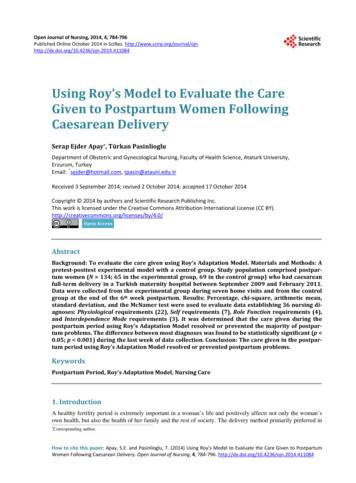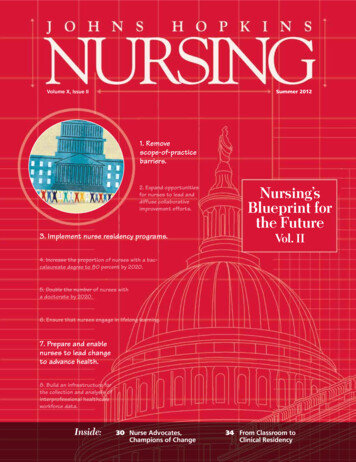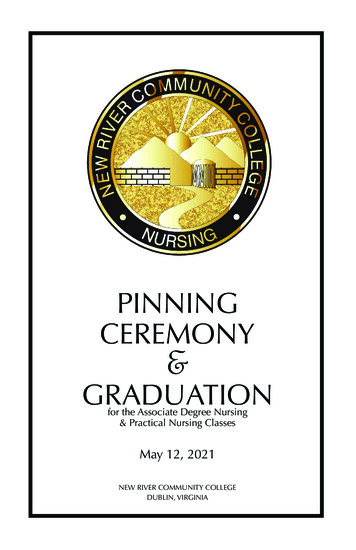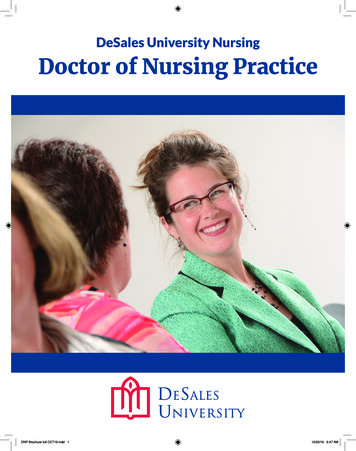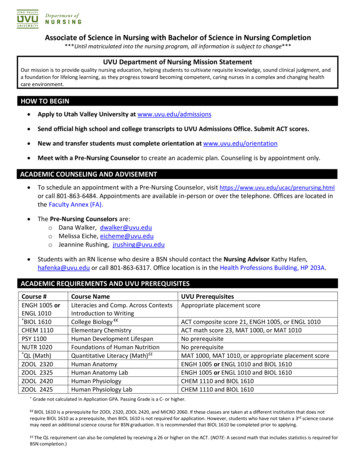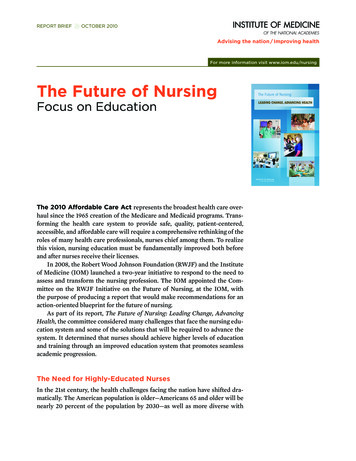
Transcription
REPORT BRIEF OCTOBER 2010Advising the nation / Improving healthFor more information visit www.iom.edu/nursingThe Future of NursingFocus on EducationThe 2010 Affordable Care Act represents the broadest health care overhaul since the 1965 creation of the Medicare and Medicaid programs. Transforming the health care system to provide safe, quality, patient-centered,accessible, and affordable care will require a comprehensive rethinking of theroles of many health care professionals, nurses chief among them. To realizethis vision, nursing education must be fundamentally improved both beforeand after nurses receive their licenses.In 2008, the Robert Wood Johnson Foundation (RWJF) and the Instituteof Medicine (IOM) launched a two-year initiative to respond to the need toassess and transform the nursing profession. The IOM appointed the Committee on the RWJF Initiative on the Future of Nursing, at the IOM, withthe purpose of producing a report that would make recommendations for anaction-oriented blueprint for the future of nursing.As part of its report, The Future of Nursing: Leading Change, AdvancingHealth, the committee considered many challenges that face the nursing education system and some of the solutions that will be required to advance thesystem. It determined that nurses should achieve higher levels of educationand training through an improved education system that promotes seamlessacademic progression.The Need for Highly-Educated NursesIn the 21st century, the health challenges facing the nation have shifted dramatically. The American population is older—Americans 65 and older will benearly 20 percent of the population by 2030—as well as more diverse with
respect not only to race and ethnicity but alsoother cultural and socioeconomic factors. In addition to shifts in the nation’s demographics, therealso have been shifts in that nation’s health careneeds. Most health care today relates to chronicconditions, such as diabetes, hypertension, arthritis, cardiovascular disease, and mental health conditions, due in part to the nation’s aging population and compounded by increasing obesity levels.While chronic conditions account for most of thecare needed today, the U.S. health care system wasprimarily built around treating acute illnesses andinjuries, the predominant health challenges of theearly 20th century.The ways in which nurses were educated during the 20th century are no longer adequate fordealing with the realities of health care in the 21stcentury. As patient needs and care environmentshave become more complex, nurses need to attainrequisite competencies to deliver high-qualitycare. These competencies include leadership,health policy, system improvement, research andevidence-based practice, and teamwork and collaboration, as well as competency in specific content areas such as community and public healthand geriatrics. Nurses also are being called uponto fill expanding roles and to master technological tools and information management systemswhile collaborating and coordinating care acrossteams of health professionals. To respond to theseincreasing demands, the IOM committee calls fornurses to achieve higher levels of education andsuggests that they be educated in new ways thatbetter prepare them to meet the needs of the population.needed to negotiate with the health care team,navigate the regulatory and access stipulationsthat determine patients’ eligibility for enrollmentin health and social service programs, or understand how these programs and health policiesaffect patients and health outcomes. Nursing curricula need to be reexamined, updated, and adaptive enough to change with patients’ changingneeds and improvements in science and technology, the IOM committee says.Many nursing schools have dealt with therapid growth of health research and knowledge bycompressing available information into the curriculum and adding layers of content that requiremore instruction. New approaches and educational models must be developed to respond toburgeoning information in the field. For example,fundamental concepts that can be applied acrossall settings and in different situations need to betaught, rather than requiring rote memorization.Competencies also must move from task-basedproficiencies to higher-level competencies thatprovide a foundation for care management knowledge and decision-making skills under a variety ofclinical situations and care settings. Additionally,emerging new competencies in decision making,quality improvement, systems thinking, and teamleadership must become part of every nurse’s professional formation.Entering the ProfessionNursing is unique among the health care professions in the United States in that it has multipleeducational pathways leading to an entry-levellicense to practice. Nursing students are able topursue three different educational pathways tobecome registered nurses (RNs): the bachelor’s ofscience in nursing (BSN), the associate’s degree innursing (ADN), and the diploma in nursing. Morerecently, an accelerated, second-degree bachelor’sprogram for students who possess a baccalaureatedegree in another field also has become a popularoption. These various pathways provide numer-An Improved Education SystemMuch of nursing education revolves around acutecare rather than community settings that includeaspects of primary care, public health, and longterm care. Nursing education frequently does notincorporate the intricacies of care coordinationand transitions. Nor does it promote the skills2
ous opportunities for women and men of modestmeans and diverse backgrounds to access careersin an economically stable field.The qualifications and level of educationrequired for entry into the nursing profession havebeen widely debated by nurses, nursing organizations, academics, and a host of other stakeholdersfor more than 40 years. Although a BSN educationis not a panacea for all that is expected of nursesin the future, it does, relative to other educationalpathways, introduce students to a wider rangeof competencies in such arenas as health policyand health care financing, community and publichealth, leadership, quality improvement, and systems thinking. Care within the hospital continuesto grow more complex, with nurses having to makecritical decisions associated with care for sicker,frailer patients and having to use more sophisticated, life-saving technology coupled with infor-mation management systems that require skills inanalysis and synthesis. Care outside the hospital isbecoming more complex as well. Nurses are beingcalled on to coordinate care among a variety of clinicians and community agencies; to help patientsmanage chronic illnesses, thereby preventingacute care episodes and disease progression; andto use a variety of technological tools to improvethe quality and effectiveness of care. A more educated nursing workforce would be better equippedto meet the demands of an evolving health caresystem, and this need could be met by increasingthe percentage of nurses with a BSN. An increasein the proportion of nurses with a BSN also wouldcreate a workforce poised to achieve higher levels of education at the master’s and doctoral levels, required for nurses to serve as primary careproviders, nurse researchers, and nurse faculty—positions currently in great demand across theDistribution of the registered nurse population by highest nursing or nursing-related educational preparation,1980-2008.3,500Number of RNs torate19921996Degree programBachelor’sFigure 4-6.epsSOURCE: Health Resources and Services Administration3AssociateDiploma
profession and within the health care system.The committee recommends that the proportionof nurses with baccalaureate degrees be increasedto 80 percent by 2020. While it anticipates thatit will take a few years to build the educationalcapacity needed to achieve this goal, the committee maintains that it is bold, achievable, andnecessary to move the nursing workforce to anexpanded set of competencies, especially in thedomains of community and public health, leadership, systems improvement and change, research,and health policy.Improving the education system and achieving a more educated workforce—specificallyincreasing the number of nurses with baccalaureate degrees—can be accomplished through a number of different programs and educational models,including: traditional RN-to-BSN programs; traditional 4-year BSN programs at both universities and some community colleges; educationalcollaboratives that allow for automatic and seamless transitions from an ADN to a BSN; new providers of nursing education such as proprietary/for-profit schools; simulation and distance learning through online courses; and academic-servicepartnerships.In addition to increased numbers of BSN-educated nurses, schools of nursing must build theircapacities to prepare more students at the graduate level who can assume roles in advanced practice, leadership, teaching, and research. While 13percent of nurses hold a graduate degree, fewerthan one percent have a doctoral degree. Nurseswith doctorates are needed to teach future generations of nurses and to conduct research thatbecomes the basis for improvements in nursingscience and practice. The committee recommendsdoubling the number of nurses with a doctorateby 2020.are required to develop a more highly-educatedworkforce. Nursing education should serve asa platform for continued lifelong learning andshould include opportunities for seamless transition to higher degree programs. The committeerecommends that nurses and nursing studentsand faculty continue their education and engagein lifelong learning.Bridge programs and educational pathwaysbetween undergraduate and graduate programs—specifically programs such as LPN-to-BSN,ADN-to-BSN, and ADN-to-MSN—are designedto facilitate academic progression to higher levels of education. The ADN-to-MSN program, inparticular, is establishing a significant pathwayto advanced practice and some faculty positions.Financial support to help build capacity for theseprograms will be important, including fundingfor grants and scholarships for nurses wishingto pursue these pathways. For example, diplomaprograms could be phased out, leaving federalresources that could be reallocated to expand baccalaureate and higher education programs.Bridge programs and seamless educationalpathways also offer opportunities for increasing the overall diversity of the student body andnurse faculty with respect to race and ethnicity,geography, background, and personal experience.Although the composition of the nursing studentbody is more racially and ethnically diverse thanthat of the current workforce, diversity continuesto be a challenge within the profession. Greaterracial and ethnic diversity among all health careproviders leads to stronger relationships withpatients in non-white communities, which arelikely to grow as the U.S. population becomesincreasingly diverse. Nursing schools and otherrelevant groups need to create programs torecruit and retain more individuals from racialand ethnic minorities, as well as men—who makeup just seven percent of all RNs—into the nursingprofession.Lifelong LearningProfound changes in the education of nurses,both before and after they receive their licenses,4
Enough Nurses with the Right Skillsods of time during which nursing graduates canacquire the knowledge and skills to deliver safe,quality care that meets defined standards of practice, can help new nurses develop skills in suchimportant areas as organizing work; establishingpriorities; and communicating with physiciansand other professionals, patients, and families.In addition, transition-to-practice residency programs can help develop leadership and technicalskills in order to provide quality care. Residencyprograms are supported predominantly in hospitals and larger health systems, with a focus onacute care; they also need to be developed andevaluated outside of acute care settings to accommodate the coming shift of care from hospital tocommunity-based settings and the need for nursing expertise in chronic illness management, careof older adults in home settings, and transitionalservices.While the evidence is limited because resi-Significant barriers must be overcome if theshortage of nurses is going to be offset and moreadvanced and expanded nursing roles are goingto be filled. Having enough nurses with the rightkinds of skills will contribute to the overall safetyand quality of a transformed health care system.One such barrier is high turnover rates, whichcontinue to destabilize the nurse workforce inthe United States. The costs associated with theseturnover rates are significant, particularly in hospitals and nursing homes. The high rates amongnewly graduated nurses, in particular, highlightthe need for a greater focus on managing the transition from school to practice.Nurse residency programs, recommendedby the Joint Commission in 2002, can provideimportant hands-on experience for newly graduated nurses or those transitioning into a new areaof practice. These planned, comprehensive peri-Percentage of minority students enrolled in nursing programs by race/ethnicity and program type, can Indian or Alaskan NativeHispanicFigure 8208.7Percentage25Asian or Pacific IslanderAfrican AmericanNOTE: ADN associate’s degree programs; BSN bachelor’s of science programs; BSRN RN-to-BSN programs;DIP diploma nursing programs; DOC nursing school programs offering doctoral degrees; LPN licensed practicalnursing programs; LVN licensed vocational nursing programs.SOURCE: Reprinted with Permission from the National League for Nursing.5
Recommendationsdency programs are not widespread, they havebeen shown to help reduce turnover rates for newgraduate RNs, reduce costs, increase stability instaffing levels, and help first-year nurses developcritical competencies in clinical decision makingand autonomy in providing patient care. The committee recommends that actions be taken to support nurses’ completion of transition-to-practicenurse residency programs after they have completed a prelicensure or advanced degree programor when they are transitioning into new clinicalpractice areas.Increase the proportion of nurses with abaccalaureate degree to 80 percent by 2020.Academic nurse leaders across all schools of nursing should work together to increase the proportion of nurses with a baccalaureate degree from50 to 80 percent by 2020. These leaders shouldpartner with education accrediting bodies, private and public funders, and employers to ensurefunding, monitor progress, and increase the diversity of students to create a workforce prepared tomeet the demands of diverse populations acrossthe lifespan.Conclusion The Commission on Collegiate Nursing Education,working in collaboration with the National Leaguefor Nursing Accrediting Commission, should requireall nursing schools to offer defined academic pathways, beyond articulation agreements, that promoteseamless access for nurses to higher levels of education.With more than 3 million members, the nursingprofession is the largest segment of the nation’shealth care workforce. Working on the frontlines of patient care, nurses have a direct effecton patient care. Their regular, close proximity topatients and scientific understanding of care processes across the continuum of care give them aunique ability to effect wide-reaching changes inthe health care system. Nurses must be preparedto meet diverse patients’ needs; function as leaders; and advance science that benefits patientsand the capacity of health professionals to deliversafe, quality patient-centered care. If new nursesare to succeed in this complex and evolving healthcare system, nursing education needs to be transformed. Health care organizations should encourage nurseswith associate’s and diploma degrees to enter baccalaureate nursing programs within 5 years of graduation by offering tuition reimbursement, creating aculture that fosters continuing education, and providing a salary differential and promotion. Private and public funders should collaborate, andwhen possible pool funds, to expand baccalaureateprograms to enroll more students by offering scholarships and loan forgiveness, hiring more faculty,expanding clinical instruction through new clinical partnerships, and using technology to augmentinstruction. These efforts should take into consideration strategies to increase the diversity of the nursing workforce in terms of race/ethnicity, gender, andgeographic distribution. The U.S. Secretary of Education, other federal agencies including the Health Resources and ServicesAdministration, and state and private funders shouldexpand loans and grants for second-degree nursingstudents. Schools of nursing, in collaboration with other healthprofessional schools, should design and implementearly and continuous interprofessional collaborationthrough joint classroom and clinical training opportunities. Academic nurse leaders should partner with healthcare organizations, leaders from primary and secondary school systems, and other community organizations to recruit and advance diverse nursing students.6
Double the number of nurses with a doctorateby 2020. Academic administrators should require all facultyto participate in continuing professional development and to perform with cutting-edge competencein practice, teaching, and research.Schools of nursing, with support from privateand public funders, academic administratorsand university trustees, and accrediting bodies,should double the number of nurses with a doctorate by 2020 to add to the cadre of nurse faculty and researchers, with attention to increasingdiversity. All health care organizations and schools of nursing should foster a culture of lifelong learning andprovide resources for interprofessional continuingcompetency programs. Health care organizations and other organizationsthat offer continuing competency programs shouldregularly evaluate their programs for adaptability,flexibility, accessibility, and impact on clinical outcomes and update the programs accordingly. The Commission on Collegiate Nursing Educationand the National League for Nursing AccreditingCommission should monitor the progress of eachaccredited nursing school to ensure that at least 10percent of all baccalaureate graduates matriculateinto a master’s or doctoral program within 5 years ofgraduation.Implement nurse residency programs. Private and public funders, including the HealthResources and Services Administration and theDepartment of Labor, should expand funding forprograms offering accelerated graduate degrees fornurses to increase the production of master’s anddoctoral nurse graduates and to increase the diversity of nurse faculty and researchers.State boards of nursing, accrediting bodies, thefederal government, and health care organizations should support nurses’ completion of atransition-to-practice program (nurse residency)after they have completed a prelicensure oradvanced practice degree program or when theyare transitioning into new clinical practice areas. Academic administrators and university trustees should create salary and benefit packagesthat are market competitive to recruit and retainhighly qualified academic and clinical nursefaculty.The following actions should be taken to implement and support nurse residency programs: State boards of nursing, in collaboration withaccrediting bodies such as the Joint Commissionand the Community Health Accreditation Program,should support nurses’ completion of a residencyprogram after they have completed a prelicensureor advanced practice degree program or when theyare transitioning into new clinical practice areas.Ensure that nurses engage in lifelong learning.Accrediting bodies, schools of nursing, healthcare organizations, and continuing competencyeducators from multiple health professions shouldcollaborate to ensure that nurses and nursing students and faculty continue their education andengage in lifelong learning to gain the competencies needed to provide care for diverse populations across the lifespan. The Secretary of Health and Human Services shouldredirect all graduate medical education funding fromdiploma nursing programs to support the implementation of nurse residency programs in rural andcritical access areas. Health care organizations, the Health Resources andServices Administration and Centers for Medicareand Medicaid Services, and philanthropic organizations should fund the development and implementation of nurse residency programs across all practicesettings. Faculty should partner with health care organizations to develop and prioritize competencies so curricula can be updated regularly to ensure that graduates at all levels are prepared to meet the currentand future health needs of the population. Health care organizations that offer nurse residencyprograms and foundations should evaluate the effectiveness of the residency programs in improving theretention of nurses, expanding competencies, andimproving patient outcomes. The Commission on Collegiate Nursing Educationand the National League for Nursing AccreditingCommission should require that all nursing studentsdemonstrate a comprehensive set of clinical performance competencies that encompass the knowledge and skills needed to provide care across settings and the lifespan.7
Committee on the Robert Wood Johnson FoundationInitiative on the Future of Nursing, at the Institute ofMedicineDonna E. Shalala (Chair)President, University of Miami,Coral Gables, FLLinda Burnes Bolton (ViceChair) Vice President and ChiefNursing Officer, Cedars-SinaiHealth System and ResearchInstitute, Los Angeles, CAMichael R. BleichDean and Dr. Carol A. Lindeman Distinguished Professor, Vice Provost for Interprofessional Education andDevelopment Oregon Healthand Science University Schoolof Nursing, PortlandTroyen A. BrennanExecutive Vice President, ChiefMedical Officer, CVS Caremark,Woonsocket, RIRobert E. CampbellVice Chairman (retired), Johnson & Johnson, NewBrunswick, NJLeah DevlinProfessor of the Practice,University of North Carolina School of Public Health,RaleighCatherine DowerAssociate Director of Research,Center for the Health Professions, University of California,San FranciscoRosa Gonzalez-GuardaAssistant Professor, School ofNursing and Health Studies,University of Miami, CoralGables, FLJennie Chin HansenChief Executive Officer,American Geriatrics Society,New YorkC. Martin HarrisChief Information Officer,Cleveland Clinic, OHAnjli Aurora HinmanCertified Nurse-Midwife, IntownMidwifery, Atlanta, GAWilliam D. NovelliDistinguished Professor,McDonough School of Business, Georgetown University,Washington, DCLiana Orsolini-HainNursing Instructor, City Collegeof San Francisco, CAYolanda PartidaDirector, National Center,Hablamos Juntos, and Assistant Adjunct Professor, Centerfor Medical Education andResearch,University of California, San Francisco, FresnoRobert D. ReischauerPresident, The Urban Institute,Washington, DCJohn W. RoweProfessor, Mailman School ofPublic Health, Department ofHealth Policy and Management,Columbia University, New YorkBruce C. VladeckSenior Advisor, NexeraConsulting, New YorkDavid C. GoodmanProfessor of Pediatric andof Community and FamilyMedicine, Children’s Hospitalat Dartmouth, The DartmouthInstitute for Policy and ClinicalPractice, Hanover, NHStudy StaffSusan HassmillerStudy DirectorGina IveyCommunications DirectorAdrienne Stith ButlerSenior Program OfficerLori MelicharResearch DirectorAndrea M. SchultzAssociate Program OfficerJulie FairmanNurse Scholar-in-ResidenceKatharine BothnerResearch AssociateJudith A. SalernoExecutive Officer, IOMThelma L. CoxAdministrative AssistantTonia E. DickersonSenior Program AssistantConsultantsChristine GormanTechnical WriterRona BriereStudy SponsorThe Robert Wood Johnson FoundationAdvising the nation / Improving health500 Fifth Street, NWWashington, DC 20001TEL 202.334.2352FAX 202.334.1412www.iom.eduThe Institute of Medicine serves as adviser to the nation to improve health.Established in 1970 under the charter of the National Academy of Sciences,the Institute of Medicine provides independent, objective, evidence-based adviceto policy makers, health professionals, the private sector, and the public.Copyright 2010 by the National Academy of Sciences. All rights reserved.
mittee on the RWJF Initiative on the Future of Nursing, at the IOM, with the purpose of producing a report that would make recommendations for an action-oriented blueprint for the future of nursing. As part of its report, The Future of Nursing: Leading Change, Advancing Health, the committee considered ma




